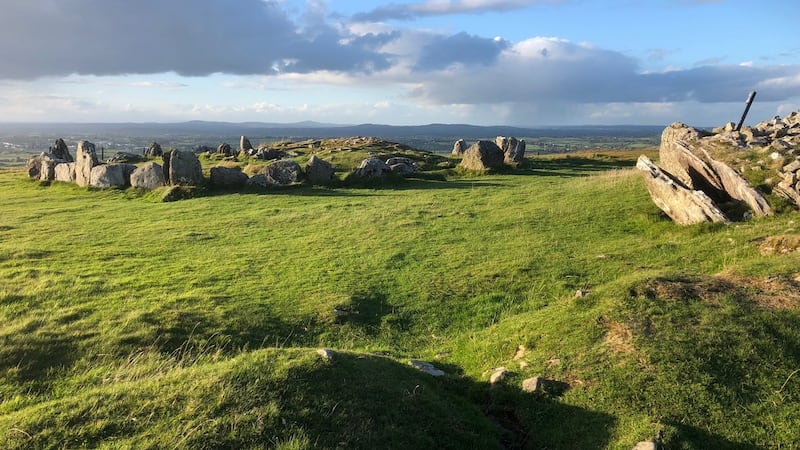Despite the name (or maybe because of it), this highest hill in Co Meath, is a truly enchanting place, a “hidden gem” of Ireland’s Ancient East. I came on the autumn equinox when the rising sun visits the wonderfully scratched motifs on the back-stone of the hill’s 5,000-year-old summit cairn, known as Cairn T. And on this September 21st day of showers and rainbows, it did – though I personally was just too late to witness that special play of sun and Neolithic art, science and engineering.
The hill’s geographical, cultural, historical and mythological contexts, and the attempts over the years to decipher purpose and meaning, are too many and varied to cover in an article such as this. I recommend a prior visit to the friendly and knowledgeable people of the Megalithic Centre (info@loughcrewmega.com), just 50 meters from the hill’s access car park.
Here, a perusal over coffee of "Loughcrew Cairns, Sliabh na Caillí, A Visitor's Guide" (€10), will greatly enrich your visit. Indeed, the centre's excellent hostel and campsite and wide range of tours and activities may tempt you to stay – and maybe even to pay a solo visit to the hill with just stars and stones and shadows for company.

Technically, the walk is easy, though the ground is steep and can be slippery in wet weather. Steps, flagstones and posts guide the visitor to the pleasant, grassy summit where inevitably we are prompted to think about those ancestors of ours, for whom this was a special place. But these were not just people of cold stones and burnt bones. They were ordinary people of warm hearts who lived, loved and laboured in the lowlands around and below where you stand. They would have fished the distant lakes and rivers, hunted and gathered in its forests, fought off wolves, farmed some land, gossiped and talked of the weather.
The essentially unchanging Cairn T and the other “sacred” places of Loughcrew would have seen countless dramas play out around them in the great sweep of time between you and your ancestors at Loughcrew. Memories would have become myths within only decades of completion; belief systems, people and language would have changed many times, often peacefully but sometimes violently through invasion, expulsions, enslavement and massacres. Chiefs and shamans would have led and misled their people, often protecting and sustaining their people and sometimes letting them down and exploiting their dependencies and despairs.

The more fragile signatures of the lives and livelihoods of these ordinary people are lost to us. Thus, there will be no history or story and few clues to guide you towards understanding the people or the many different meanings they would have placed on these silent, secretive stones. Your own quiet imaginings, and the connections you make as a fellow human under the same sky and breathing the same air, will be as good as anyone’s, and will make a visit special and personal.
Map: Panels in the Loughcrew Cairns car park.
Start and finish: Car park on small road off the L2800 between Kells and Oldcastle; approach well sign-posted.
Effort and suitability: A visit deserves about 90 minutes; easy but steep in spots, requires well-gripped shoes or boots.
Facilities and refreshments: Loughcrew Megalithic Centre, just 50 meters from car park.











